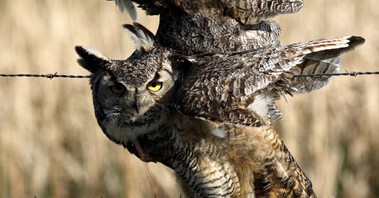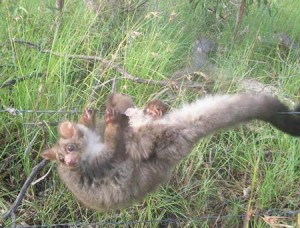
 Every year, thousands of animals face a cruel death on barbed wire fences. Barbed wire is a major hazard for our wildlife, and not just small animals, but large ones too like kangaroos. Entanglement on barbed wire, usually the top strand, results in a cruel slow death, most often from starvation, or being attacked and eaten by other animals. Over 70 species of Australian native wildlife have been identified as regular victims of barbed wire fences, especially nocturnal animals like bats, possums and owls. Most fail to see fence wires and birds and bats get caught on windy days. Many animals rescued from fences are too badly injured to ever be returned to the wild, further decreasing wild numbers.
Every year, thousands of animals face a cruel death on barbed wire fences. Barbed wire is a major hazard for our wildlife, and not just small animals, but large ones too like kangaroos. Entanglement on barbed wire, usually the top strand, results in a cruel slow death, most often from starvation, or being attacked and eaten by other animals. Over 70 species of Australian native wildlife have been identified as regular victims of barbed wire fences, especially nocturnal animals like bats, possums and owls. Most fail to see fence wires and birds and bats get caught on windy days. Many animals rescued from fences are too badly injured to ever be returned to the wild, further decreasing wild numbers.
Kangaroos get hung up in fences, plain or barbed wire, on either top strands that are too high to clear or bottom strands too low to go under. Wetlands fenced off too close to the water level prevent water birds like cranes from landing or taking off, and even drown some animals trying to cross fence lines.
 But there is an alternative – wildlife friendly fencing (WFF). Wildlife friendly fencing:
But there is an alternative – wildlife friendly fencing (WFF). Wildlife friendly fencing:
- Does not entangle or harm wildlife
- Allows the appropriate free movement of wildlife across rural and urban landscapes and may mean no fence at all
- Does not use barbed wire, especially on top strands of fences, which are hotspots for wildlife injuries and death – hotspots include ridgelines, feed trees, wildlife corridors, new fences and fences over or near waterways
What can we do to protect our wildlife? Some solutions include:
- Using split polypipe over wire at hotspots
- Choosing wooden fencing over wire
- Hanging old CDs and DVDs from fences to alert and deter birds, bats and other animals, and make fences more visible, even at night
- Use electrical fence tape as the top strands instead of wire
What can we do if we don’t have WFF?
- Make your fences as wildlife friendly as possible
- Monitor fences, especially barbed wire fences, in your area (daily if possible)
- Encourage landholders to go ‘wildlife friendly’
- Encourage your local natural resource management groups to promote WFF
- Distribute WFF brochures and info when you can
- Visit www.wildlifefriendlyfencing.com for advice and info. They also sell t-shirts, car stickers and other products to help spread the word
- Report all entangled animals to your local wildlife rescue service or the RSPCA. Visit www.fauna.org.au
- Please do not attempt to handle or rescue wild animals of any kind yourself
 The consideration of wildlife on our farms, whether urban or rural, should also extend to fruit tree netting. Never use monofilament netting. Be responsible when netting your trees and garden, and check for trapped wildlife daily.
The consideration of wildlife on our farms, whether urban or rural, should also extend to fruit tree netting. Never use monofilament netting. Be responsible when netting your trees and garden, and check for trapped wildlife daily.
For more info please visit www.wildlifefriendlyfencing.com
If you find an injured or sick flying fox or any bat, please contact the Bat Rescue Hotline urgently on 0488 228 134 and for more info please visit www.bats.org.au
